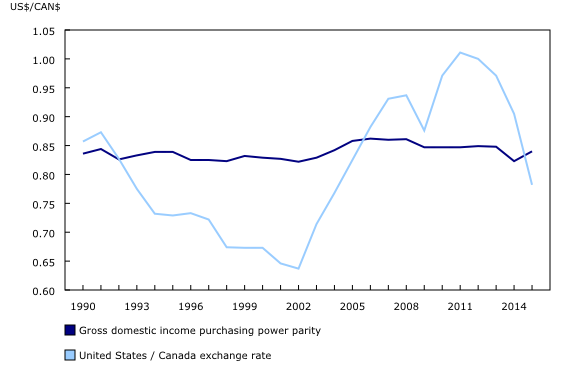Purchasing power parities, 2015
Archived Content
Information identified as archived is provided for reference, research or recordkeeping purposes. It is not subject to the Government of Canada Web Standards and has not been altered or updated since it was archived. Please "contact us" to request a format other than those available.
Released: 2017-04-24
In 2015, the purchasing power parity (PPP) for gross domestic income from the Canada / United States bilateral program was $0.84 US per Canadian dollar, meaning for every dollar in Canada spent on goods and services, it cost 84.0 US cents in the United States to buy comparable items. This was up from 2014, when the PPP stood at 82.3 US cents per Canadian dollar. The PPP has been relatively stable since 1990, although it continues to be below the 2006 peak of 86.2 US cents. By contrast, $1 Canadian traded for $0.78 US in the foreign exchange market in 2015.
From 1990 to 2015, the average of the PPP and the market exchange rate were $0.84 US and $0.82 US, respectively. This trend reinforces the notion that Canadian purchasing power, which captures both traded and non-traded goods and services, is less impacted by short-term fluctuations in the market exchange rate.
Actual individual consumption was $0.84 US in 2015, its lowest level since 2002. This is reflected in continued declines since 2014 in the PPP for Clothing and Footwear (-1.8%), Household furnishings, equipment and maintenance (-4.5%), Transport (-0.3%), Communication (-3.5%) and Net purchases abroad (-7.0%).
The decrease in individual consumption was offset by an increase in construction, the largest component of gross fixed capital formation. The PPP associated with construction rose to $0.81 US in 2015, up from $0.73 US in 2014.
In 2015, per capita individual consumption was 28% higher in the United States than in Canada. Consumers from the United States spent 26% more on services than Canadians and 55% more on non-durable goods.
As of 2015, education remains the only consumer good or service purchased in Canada that is less expensive than in the United States.
Note to readers
Data on purchasing power parities (PPPs) for 2015 is now available. The PPP estimate includes prices of tradeable and non-tradeable goods and services by each country and is therefore the appropriate metric for comparing real income and consumption among countries. In contrast, market exchange rates are often driven by short term fluctuations in prices of tradeable products (oil and gold, for instance) and capital flows, therefore the market exchange rates do not fully reflect the domestic purchasing power.
Revisions
With this release, the bilateral Canada / United States program on PPPs was revised back to 2000. These annual revisions from 2000 to 2014 incorporate prices from the Organisation of Economic Cooperation and Development's (OECD) benchmark exercise for 2014.
From 2008 onward, the new Canada / United States database is also supplemented with comparable and representative prices collected from various websites. These added prices are mainly concentrated in semi-durable and durable goods, in machinery and equipment and in individual services.
Updates to PPPs for the multilateral program have also been recompiled to reflect revisions made by the OECD from 1980 to 2014.
Definitions
Purchasing power parities are estimates of the relative purchasing power between two or more currencies. At the most basic level, it is a ratio of prices for a particular commodity in two countries, with the prices expressed in their respective national currencies. Adjusted to a common currency and a common set of prices, they can be used to make international comparisons of the relative volumes of goods and services invested in or consumed. They are calculated by dividing the price of a specific item of a specific quality in one country's currency by the price of the same item in the other country, in the currency of the other country.
United States per capita expenditures in current dollars are converted to Canadian dollars by dividing them by the Fisher PPPs. These converted expenditures are then expressed as a ratio of Canadian expenditures per capita.
Comparative price levels are calculated as the PPPs divided by the exchange rate. They measure the degree to which one country's price level is above or below another's. These ratios indicate the number of units of a common currency needed to buy the same volume of goods and/or services in different countries. The rates produced are also termed "real" exchange rates.
Data for PPPs and related series include consumption (International Comparison Program) and expenditure-based System of National Accounts data from the Canada / United States bilateral program. When making international comparisons, the consumption-based classification is more appropriate, as it is controlled for the various levels of government involvement in the financing of consumption between countries.
Products
The System of Macroeconomic Accounts module features an up-to-date portrait of national and provincial economies and their structure.
The Methodological Guide: Canadian System of Macroeconomic Accounts (13-607-X) is available.
The User Guide: Canadian System of Macroeconomic Accounts (13-606-G) is also available. This publication will be updated to maintain its relevance.
Contact information
For more information, or to enquire about the concepts, methods or data quality of this release, contact us (toll-free 1-800-263-1136; 514-283-8300; STATCAN.infostats-infostats.STATCAN@canada.ca) or Media Relations (613-951-4636; STATCAN.mediahotline-ligneinfomedias.STATCAN@canada.ca).
- Date modified:


